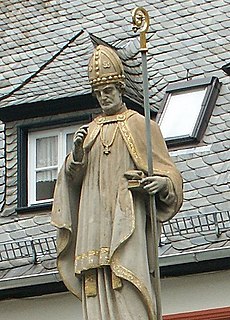Siegfried I | |
|---|---|
| Archbishop of Mainz | |
| Church | Catholic Church |
| Diocese | Electorate of Mainz |
| In office | 1060–1084 |
| Personal details | |
| Died | 16 February 1084 |
Siegfried I (died 16 February 1084) was the Abbot of Fulda from 25 December 1058 until 6 January 1060, and from January 1060 until his death in February 1084, he was Archbishop of Mainz.
Siegfried was a member of the Frankish Reginbodonen family of the Rhineland. His father, also called Siegfried, was count of the Königssondergau. Count Siegfried was succeeded by his son Udalric, who was count of the Königssondergau and advocate of the diocesan church of Mainz from 1052 to 1074. [1]
Siegfried was educated in the monastery of Fulda and became a monk there. On 25 December 1058, he was appointed abbot of Fulda and on 6 January 1060, the Empress Agnes appointed him Archbishop of Mainz. [2] In Spring 1062, he entered the political realm as a member of the faction surrounding Anno II of Cologne, who forcibly took control of the regency of the young king, Henry IV in the Coup of Kaiserswerth. [3] Nevertheless, Siegfried never had the political influence of Anno or Adalbert of Bremen, and remained a 'third force'.
In Winter 1064 – 1065, he undertook a pilgrimage to Jerusalem. In 1069 he presided over the assembly of Worms, at which Henry IV announced his intention to repudiate his wife Bertha. Siegfried wrote to Pope Alexander II asking for help with the matter. [4] In 1070, he took a pilgrimage to Rome to seek the permission of Pope Alexander II to lay down his title and abdicate, but the pope refused him. Together with Anno II of Cologne, in 1071, he founded a Benedictine monastery at Saalfeld. [5]
In 1072, under the pretext of a pilgrimage to Santiago de Compostela, he sojourned at Cluny, where he met the Abbot Hugh the Great. [6] The Mainzers, however, demanded his return before he made it to Spain. Upon his return, he ardently undertook the Cluniac reform in his diocese. In 1074, in that vein, he established the monasteries of Ravengiersburg and Hasungen.
Siegfried initially sided with Henry IV in the Investiture Controversy between the Holy Roman Emperor and the Roman Catholic Pope. He was one of the German bishops who attempted to depose Pope Gregory VII in 1076. Yet later that same year, when Gregory VII excommunicated Henry IV, Siegfried did an about-face and, at a general assembly of German Aristocrats in Tribur in October 1076, participated in the election of an anti-king, supporting the nobility opposing the Emperor in the civil war that became known as the Great Saxon revolt. Subsequently, Siegfried was driven from his diocese by the outraged royalist citizenry revolting against his rule. Nonetheless, on 25 March 1077, he crowned Henry IV's brother-in-law, duke Rudolf of Rheinfelden as Antiking, since the allied rebels of which he was a part needed the military prestige and might of a king to offset the power of the established monarch given his rapprochement with the Pope. On 26 December 1081, he crowned Herman of Salm as the second anti-king in Goslar. After 1081, he ceased to involve himself in public affairs until his death at Hasungen, where he was buried.

Guibert or Wibert of Ravenna was an Italian prelate, archbishop of Ravenna, who was elected pope in 1080 in opposition to Pope Gregory VII and took the name Clement III. Gregory was the leader of the movement in the church which opposed the traditional claim of European monarchs to control ecclesiastical appointments, and this was opposed by supporters of monarchical rights led by the Holy Roman Emperor. This led to the conflict known as the Investiture Controversy. Gregory was felt by many to have gone too far when he excommunicated the Holy Roman Emperor Henry IV and supported a rival claimant as emperor, and in 1080 the pro-imperial Synod of Brixen pronounced that Gregory was deposed and replaced as pope by Guibert.

Anno II was Archbishop of Cologne from 1056 until his death. From 1063 to 1065 he acted as regent of the Holy Roman Empire for the minor Emperor Henry IV. Anno is venerated as a saint of the Catholic Church.

Saint Lullus was the first permanent archbishop of Mainz, succeeding Saint Boniface, and first abbot of the Benedictine Hersfeld Abbey. He is historiographically considered the first official sovereign of the Electorate of Mainz.
Lambert of Hersfeld was a medieval chronicler. His work represents a major source for the history of the German kingdom of Henry IV and the incipient Investiture Controversy in the eleventh century.
Alban of Mainz was a Catholic priest, missionary, and martyr in the Late Roman Empire. He is venerated as Saint Alban of Mainz in the Catholic Church, not to be confused with Saint Alban of Verulamium.
Saint Alfanus I or Alfano I was the archbishop of Salerno from 1058 until his death. He was famed as a translator, writer, theologian, and medical doctor.
Burchard of Basle, also known as Burkart of Fenis, Burchard of Hasenburg or Burchard of Asuel, was a Bishop of Basel in the eleventh century and a supporter of Holy Roman Emperor Henry IV (1056–1106).

Peter of Aspelt was Archbishop of Mainz from 1306 to 1320, and an influential political figure of the period. He brought the archbishopric to its peak of power.

Ruthard was Archbishop of Mainz from 1089 to 1109, and a leading opponent of the Emperor Henry IV and his antipope Clement III. He spent nearly eight years in exile because of his opposition, and played a part in the successful revolt of Henry V against his father.

Benno II was Bishop of Osnabrück from 1068 until his death. He served as a close advisor and architect of Emperor Henry IV. In 1080 he founded the Benedictine abbey of Iburg Castle.

The Abbey of Fulda, from 1221 the Princely Abbey of Fulda and from 1752 the Prince-Bishopric of Fulda, was a Benedictine abbey and ecclesiastical principality centered on Fulda, in the present-day German state of Hesse.
The Goslar Precedence Dispute escalated at Pentecost in 1063 in the Goslar Collegiate Church of St. Simon and St. Jude from a dispute over the order of seating into an armed confrontation which resulted in several deaths. The background is the early medieval legal system, based mainly on personal loyalty and privileges that could be conferred or withdrawn at any time.
Saint Sturm, also called Sturmius or Sturmi, was a disciple of Saint Boniface and founder and first abbot of the Benedictine monastery and abbey of Fulda in 742 or 744. Sturm's tenure as abbot lasted from 747 until 779.
Conrad of Dhaun was a German nobleman. His relatives were the Wild- and Rhinegraves of Dhaun. He was Archbishop and Prince-elector of the Bishopric of Mainz from 1419 until his death as Conrad III. His term was marked by the Hussite wars and by serious disputes with the Landgraviate of Hesse and within the city of Mainz.

Conrad I [of Abenberg] was Archbishop of Salzburg, Austria, in the first half of the 12th century.

Saalfeld Abbey was an important medieval Benedictine monastery and Imperial Abbey in Saalfeld, Thuringia, Germany. As an imperial abbey, the monastery was under the direct auspices of the Holy Roman Emperor, and enjoyed a degree of sovereignty equivalent to a small micro state within the Empire. The monastery was founded in 1071 and existed until 1526, when it was secularised during the Reformation.
Theoderic, or Thierry, was a royalist bishop of Verdun from 1047 to 1089. Before his consecration, he was a chaplain of Henry III.
The Mainz-Hessian War of 1427 was the final military conflict in the two-century long dispute between the Archdiocese of Mainz and Landgrave of Hesse over supremacy of the Hesse region. The decisive victories of Landgrave Ludwig I over the Mainzian military leader Gottfried von Leiningen near Fritzlar and over Archbishop Konrad von Dhaun near Fulda spelled the end of Mainz's ambitions in the Hesse region. The Peace of Frankfurt, signed on December 8, 1427, decisively ended both the war and the long-standing power struggle between Hesse and Mainz.
Rüdiger Huzmann was a German religious leader who served as the Roman Catholic Bishop of Speyer from 1075 to his death. He was born into an old Speyer family with Salian connections and before c. 1065 became a canon at Speyer Cathedral and head of the Speyer cathedral school.